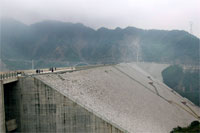

"Do not worry, the dam is perfectly stable. There is no danger of collapse, there is nothing to worry...oh, no! Allah help me!" (some one needs to Photo Shop Bagdad Bob on the PLA/Dam photo)

Cracks can be seen on the damaged Zipingpu dam wall located near the city of Dujiangyan in Sichuan province May 15, 2008. A massive earthquake caused the 760-megawatt hydropower generating unit at Zipingpu, about 9km (6 miles) upstream of Dujiangyan, to collapse, the provincial government said. Water has been released to lower water levels in the reservoir and relieve pressure on the cracked dam. REUTERS/David Gray (CHINA)

People's Liberation Army (PLA) soldiers and local residents walk across the damaged Zipingpu dam, located near the city of Dujiangyan in Sichuan province May 15, 2008. A massive earthquake caused the 760-megawatt hydropower generating unit at Zipingpu, about 9km (6 miles) upstream of Dujiangyan, to collapse, the provincial government said. Water has been released to lower water levels in the reservoir and relieve pressure on the cracked dam. REUTERS/David Gray (CHINA)
May 14, 2008 | 2221 GMT
STRATOR Strategic forcasting, Inc.
Cracks in the Zipingpu dam, most likely caused by the May 12 earthquake in Sichuan province, pose a threat to an area still reeling from the destruction caused by the earthquake. Another concern is the dam’s power station, which may be off line for months, if not longer, further reducing the electrical supply in a province already suffering shortages because of low water levels in area rivers and rising industrial demand.
Analysis
Some 2,000 Chinese troops were sent to the Zipingpu dam May 14 in an effort to repair cracks in the dam most likely caused by the May 12 earthquake in Sichuan province. Meanwhile, damage at other, smaller dams in the region is still being assessed. The Zipingpu dam was completed in 2006, one of several built to develop China’s western frontier, and created by far the largest reservoir in the affected area. (The Three Gorges Dam in neighboring Hubei province reported no damage from the earthquake.) Engineers already have begun releasing water from the Zipingpu reservoir, which has a capacity of 1 billion cubic meters, in order to relieve pressure on the dam.
A dam break would inundate the town of Dujianyan (population 600,000), which lies five miles downstream of the dam and where rescue efforts are still under way following the earthquake. The city of Chengdu, with a population of 3.75 million, is about 40 miles downstream from Zipingpu and would likely have to deal with flooding as a result of a dam break. Sichuan province also is a major grain producing area for China — 9 percent of the country’s total grain harvest comes from the province. Not all of the grain fields lie in the floodplain, but the Min Jiang River is a major source of irrigation in the region and a wall of water could knock out dams and diversions further downstream that irrigate more than 7 million acres on the Sichuan plain. With food prices already on the rise, a flood in Sichuan would further strain rice and wheat production.
Assuming that a major disaster resulting from the earthquake can be avoided at the dam, the region still faces a long-term problem of energy shortages. The hydroelectric power station inside the Zipingpu dam suffered major damage as well; walls reportedly collapsed and part of the station was said to have slid into the Min Jiang. The earthquake also shut down coal mines, if only temporarily, while they undergo safety inspections. The Zipingpu dam alone produces 3.4 billion Kilowatt hours (kWh) of electricity per year in a region that produces a total of 91.75 billion kWh annually – so, 3.7 percent of Sichuan’s electricity output is gone.
This has occurred in a region already suffering from electricity shortages because of low water levels in area rivers and rising industrial demand. Sichuan province is a significant steel and aluminum producer and supplies the rest of China with reinforcing bar (“rebar”), which is used in concrete construction. Additionally, Chengdu is home to many textile plants and electronics factories. Even production facilities not damaged by the earthquake are feeling a pinch in power supplies that will hurt production levels and have a broad impact throughout China."
This is just an example article. Stratfor publishes every single day on the critical geopolitical issues that impact the globe.
Sign Up Now for Free Intelligence.








